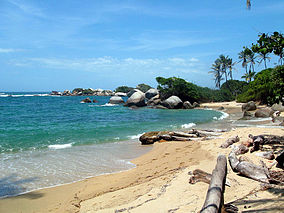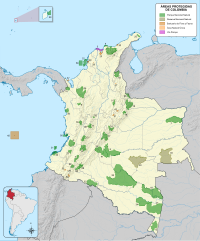Tayrona National Natural Park
| Parque Natural Nacional Tayrona | |
|---|---|
 | |
| Location | Magdalena State |
| Nearest city | Santa Marta |
| Coordinates | 11°16′N 74°03′W / 11.267°N 74.050°W |
| Area | 9.95 km2 (3.84 sq mi) |
| Established | 1969 |
| Governing body | SINAP |
The Tayrona National Natural Park (Spanish: Parque Nacional Natural Tayrona) is a protected area in the Colombian northern Caribbean region and within the jurisdiction of the Department of Magdalena and some 34 km from the city of Santa Marta. The park presents a biodiversity endemic to the area of the Sierra Nevada de Santa Marta mountain range presenting a variety of climates (mountain climate) and geography that ranges from arid sea level to 900 meters above sea level. The park covers some 30 square kilometres of maritime area in the Caribbean sea and some 150 km² of land.
It was the second most visited national park in Colombia in 2009, with 211.833 visitors. The most visited park was the Rosario and San Bernardo Corals National Natural Park.[1]
Creation
The Tayrona National Park was created by the 191st Law of the Colombian Institute for Agrarian Reform (INCORA), in order to guarantee the protection of the region and the preserving of the ecological environment.
Geography
The park has an area of 150 square kilometres. It is located in the jurisdiction of the Santa Marta municipality, in the Department of Magdalena, along the north coast of Colombia that borders on the Caribbean Sea.
Taganga is its most southern part; its western boundary goes toward the northeast following the coastline, including a kilometer of sea area, until the Piedras River. The boundary follows the left side of the river until the North Highway, and then toward the west, crossing the following places with clear demarcations on the terrain:
- Santa Rosa Hill
- Tovar Hill
- Guacamayo Pick
- Aguas Muertas Hill
- Cielito Pick
- Hondanada Site
- Humo Hill
It also crosses several creeks, like the Piedras River, Cañaveral, Santa Rosa, La Boquita, Cinto, and other water branches, including the Rodríguez and Gairaca creeks.
Animals and plants
Scholars have done an extensive classification of animal species living in the park, which include about 108 species of mammals and 300 species of birds. The black howler, the oncilla, the deer and more than 70 species of bats are among the park's typical residents.
The park's 300 species of birds include the white eagle and alone eagle. There are also approximately 31 species of reptiles, 15 species of amphibians, 202 species of sponges, 471 species of crustaceans, 96 species of anels, 700 species of mollusks, 110 species of corals and 401 species of sea and river fish.
There are more than 350 algae and more than 770 species of plants.
It is one of three national parks in the Colombian Caribbean with coral reefs on its territories, the other two being Old Providence McBean Lagoon and Rosario and San Bernardo Corals.[2]
Archaeology
There is archaeologic evidence of ancient human settlements in the area of the park until the 16th century. The place now has facilities for the eco-tourism and scouting, with paths appropriated for walks. The Archaeologic Museum of Chairama is located in the Cañaveral Site, near the mouth of the Piedras River. Other places ready for visitors are Los Naranjos Path, Castilletes Beach, The Pool, the Piedras River and the San Juan Out.
Gallery of some of the Park species
-
Black Howler Monkey, in Spanish "Mono aullador".
-
Leopardus tigrinus.
Footnotes
- ^ "Parque Corales del Rosario es el más visitado en Colombia" (in Spanish). El Tiempo. Retrieved 11 July 2010.
- ^ Cortés 2003, p. 296
References
- Cortés, Jorge (2003), Latin American coral reefs, Gulf Professional Publishing, ISBN 9780444513885.



